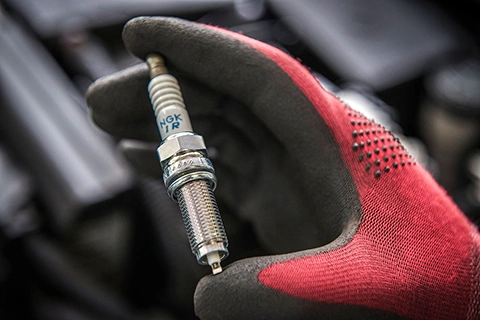You asked Google & NGK SPARK PLUG answers! – Part 2: Spark plugs

1. What is carbon fouling on spark plugs?
Carbon fouling on a spark plug is when the insulator nose at the firing tip is coated with a foreign substance such as fuel, oil, or carbon, resulting in the engine misfiring or failing to start. Instead of bridging the electrode gap and firing normally like it is supposed to, this coating makes it easier for the voltage to follow along the insulator nose, leak back down into the metal shell and ground out.
2. What causes carbon fouling on spark plugs?
Common reasons for this include the wrong spark plug heat range, a non-optimal engine combustion process and poor running conditions like continuous low-speed driving and short trips. A spark plug must reach a temperature of 450°C before it starts to self-clean by burning off carbon deposits. Regular short trips and continuous low-speed driving, however, result in the spark plug being unable to reach this critical temperature, making conditions for fouling ripe.
3. Is spark plug torque necessary?
It is absolutely necessary to tighten a spark plug to the specified turning angle or torque setting. If the torque is set too low, there is a risk of compression loss. Additionally, the insulator and electrodes may also be damaged as a result of excessive vibrations. If the torque is set too high, however, the metal shell of the spark plug will be over-stressed, increasing the likelihood of it yielding or expanding. Expansion can cause the heat dissipation zones to be disrupted. Overheating, melting of the electrodes and even engine damage are other potential outcomes.
4. How do you tighten spark plugs?
When installing, first clean the spark plug holes of lubricant, dirt and debris. Then screw in the plug finger tight until the gasket meets the cylinder head. ‘Seat’ the plug/gasket with a torque wrench to the specified torque. If using a standard wrench, turn it to the indicated angle.
The use of a spark plug socket suitable for the installation is another important factor. Such a socket should ensure that the spark plug can fit securely into it. The use of a poor-quality socket can crack the ceramic insulator during installation, leading the engine to misfire.
5. Should you replace all spark plugs at once?
It is recommended to change all of an engine’s spark plugs at the same time. If the spark plugs in an engine are older than one another, this will mean that they will not age simultaneously. If one or two of the spark plugs in an engine begin to deteriorate or malfunction before the others, the combustion of the air-fuel mixture will be insufficient since an adequate amount of sparks are not being generated. This will lead to a loss of engine power and reduced fuel economy.
6. Do NGK spark plugs come pre-gapped?
The vast majority of NGK spark plugs are pre-gapped to the manufacturer’s engine specifications, meaning no adjustment is necessary. A spark plug, however, may fit numerous types of engines, which can result in the space between the ground electrode and centre electrode not being an exact match to the manufacturer’s engine specifications. If gapping the electrodes, NGK SPARK PLUG recommends using a pin gauge or round wire-style gap tool to measure the gap, while refraining from moving the ground electrode any more than 0.20mm.
7. What are multi-ground electrode spark plugs?
Unlike traditional spark plugs which feature one ground (side) electrode, multi-ground electrode spark plugs can have two, three and four ground electrodes. These plugs provide high resistance to wear because if one ground electrode fails or wears, there is an instant replacement. Just because these types of plugs have multi electrodes, however, they do not create multiple sparks. In fact, only one spark is ever created at a time, both for traditional and multi-ground electrode spark plugs.
8. Why does a spark plug need a resistor?
A resistor suppresses ignition noise which is generated during sparking. This noise, often referred to as radio frequency interference (RFI) or electromagnetic interference (EMI), can disrupt electronic signals, affecting the performance of two-way radios, sound systems, mobile phones and also engine management systems. The majority of on-road vehicles contain a resistor, which on the products of NGK SPARK PLUG, is demonstrated by the letter ‘R’ within the code visible on the spark plug’s ceramic insulator.
9. What is ceramic used in spark plugs?
Most spark plugs used today feature a single-ceramic insulator made from aluminium oxide, with other types of ceramic materials like porcelain used in the past. This provides many benefits, including thermal conductivity and superior insulation. Resistance to overheating, thermal and mechanical shock are other stand-out features. NGK SPARK PLUG’s company roots are in the manufacture of ceramics, which is one of the reasons why the company is the world’s leading ignition and sensor specialist.
10. When should you use colder spark plugs? Do hotter spark plugs make a difference?
This depends on the type of engine being used. Low power engines such as lawnmowers and chainsaws don’t produce large amounts of heat, meaning that a ‘hot’ spark plug (with a low heat range) is needed to reach optimum performance temperature. High-performance engines, however, generate a large amount of heat, resulting in the requirement for a ‘cold’ spark plug (with a high heat range). The heat range number, which typically varies between 5-10, is featured within a spark plug’s code (found on the ceramic insulator). This number illustrates how ‘hot’ or ‘cold’ the particular plug in question is. The lower the number (e.g., 5 or 6), the hotter a spark plug is, whereas the higher the number (e.g., 9 or 10), the colder the spark plug is.
While this and the preceding blog have provided some technical insight into the workings of NGK SPARK PLUG’s most famous product, the company also manufactures many other ignition and sensor products. Join us next time when we tackle the most-asked Google questions regarding that indispensable component of the diesel engine, the mighty glow plug.








